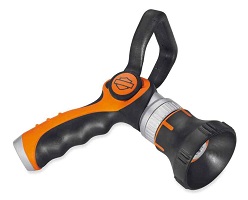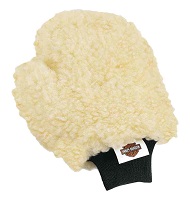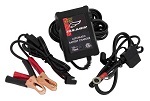Storing your Motorcycle for the Winter of 2020-21
Posted by Jason, from the Black Hills of South Dakota on Nov 1st 2020
Manoman, what a year it’s been. Can we all can agree that it’s time to kick 2020 to the curb? Yes we can! After watching any evening newscast, it’s a wonder any of us are still sane. And now, we read that virus experts are telling us that Thanksgiving might be different this year. No crowds, no planes, no family gatherings - no fun. What’s next? Cancel Holiday celebrations?
Looking back, and depending on your view, Sturgis was probably one of very few bright memories for this past year. Even in the midst of COVID, crowds were reportedly larger than in 2019. Of course, there were the inevitable reports in the weeks following the rally that it was a bad thing, or so we were told. You couldn’t convince those that attended that it was anything but wonderful.
For sure, COVID has changed many of our lives, and that is sad. To make us motorcyclists even sadder, especially those that live in colder climates, it will soon be too cold to ride. So much so that one day in the next month or two, many of us face the task of putting the bike up for winter. Can it get any worse?
With that said, here is our annual “Storing your Motorcycle for the Winter Blog for 20-21. At least this guidance hasn’t changed much. While it's the same thing year after year, it needs to be done!
Collapsed down to the major tasks involving winter storage, you need to wash it, prepare it, park it inside, raise it off the floor, and cover it. It's easy and will only take a few hours. This way, when spring rolls around it'll start on the first attempt, and it'll look just like it did when you covered it for winter.
So, here is the expanded list of things you need to do - a checklist of sorts. It’s easy. Wisconsin Harley-Davidson carries most of what you need. If available, a link is provided on the images below. Just click the image and another page will open. The items that don't have a link are readily obtained at your local hardware store or auto parts store.
Here are the simple steps to take to winterize your motorcycle:
- Wash it, and wash it good. You are looking for dirt – that’s the enemy. Use a nozzle like the one here and blast out every crack and crevice - any place dust and dirt can hide. Use a mild detergent with rags, cleaning brushes, etc. Once all the dust and dirt is removed, blast again to remove all soap residue, then use a chamois, then blow-dry the bike. Make sure all wheel spokes are thoroughly dry, too.
- Change the oil and the oil filter using high grade oil for motorcycles, and filters. In addition to lubricating the engine, oil also cleans the engine. Stands to reason that oil gets dirty over time. That's why we change it frequently during the riding season. Changing the oil for storage means the bike sits with new, fresh oil that is free of contaminants. Never store a bike without changing the oil first!
- Yes, gasoline can deteriorate over time - through evaporation and oxidation. Old, untreated gas gets sort of gummy, and can leave varnish deposits throughout the fuel system. To avoid this, it needs to be treated for winter. After adding a gasoline stabilizer to the fuel tank, fill it up with fresh gasoline, and then run the engine for a few minutes to ensure the stabilized fuel runs through all of the fuel lines. Then, top off the tank to the brim, leaving as little air as possible inside the tank. A gasoline stabilizer like STA-BIL is a favorite among bikers. Remember, gasoline deteriorates over time. A stabilizer keeps the gasoline stable so that you'll have a smooth running experience in the spring.
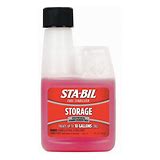
- Once the gasoline is stabilized as above, remove the plugs and squirt a teaspoon (or so) of motor oil into the cylinders. Before reinstalling the plugs, turn the engine over several revs to coat the cylinder walls, piston and rings. Then, replace and tighten the plugs.

- Plug the exhaust outlet(s) with steel wool, or cover with plastic wrap. Pull the wool into large pieces and stuff into the exhaust outlets. This will keep all sorts of tiny creatures and critters from climbing into the exhaust system.
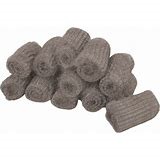
- Remove the battery and store it in a suitable location. Batteries lose voltage over time, unless charged. It is common for a battery self-discharge as much as 10-15% each month if it is left just sitting. Do the math. A battery tender will charge the battery when the voltage drops below the tender's threshold. This will prevent a dead battery in spring.
- Raise the bike on a stand, keeping it off the floor. It's not a good idea to leave the tires in one place on the floor. Unless you want to roll the bike every few days, this is the way to go.

- Cover the bike with a high quality cover, even if it is stored in the garage. Doing this will keep the dust off of it, and for those in snow country, will also protect the bike from salt residue and other chemicals dragged in by your car after driving in the snow. Ensure the bike is stored over carpet, plywood, etc. Bare concrete is not good because moisture will rise up off the floor and cling to the bike.
REMEMBER: Store the bike in your garage or basement. DO NOT STORE OUTSIDE.
Have a Happy Holiday Season and a short, safe winter. Fear not. Spring is just around the corner, and down several blocks. Hopeful, we can screw the COVID virus over the winter months.


